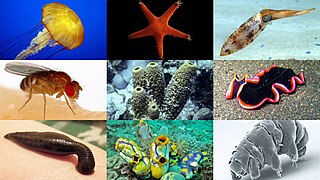
Invertebrates is an umbrella term describing animals that neither develop nor retain a vertebral column, which evolved from the notochord. It is a paraphyletic grouping including all animals excluding the chordate subphylum Vertebrata, i.e. vertebrates. Well-known phyla of invertebrates include arthropods, mollusks, annelids, echinoderms, flatworms, cnidarians and sponges.
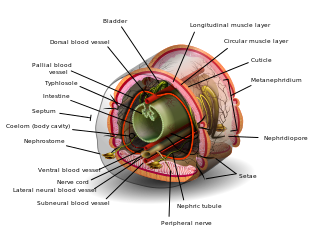
The coelom is the main body cavity in many animals and is positioned inside the body to surround and contain the digestive tract and other organs. In some animals, it is lined with mesothelium. In other animals, such as molluscs, it remains undifferentiated. In the past, and for practical purposes, coelom characteristics have been used to classify bilaterian animal phyla into informal groups.

In zoological nomenclature, a subphylum is a taxonomic rank below the rank of phylum.
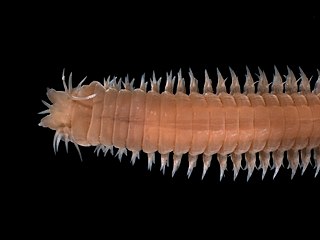
The Trochozoa are a proposed Lophotrochozoa clade that is a sister clade of Bryozoa and Platyzoa. The clade would include animals in five phyla: the Nemertea, the Annelida, the Mollusca, and the two Brachiozoan phyla, Brachiopoda and Phoronida. Both annelids and molluscs have been suggested as the sister group of Brachiozoa. It has also been proposed that nemerteans are actually a clade of annelids.
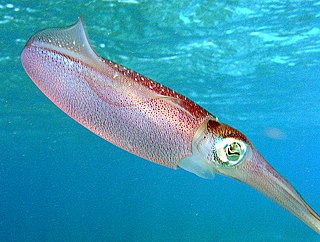
Lophotrochozoa is a clade of protostome animals within the Spiralia. The taxon was established as a monophyletic group based on molecular evidence. The clade includes animals like annelids, molluscs, bryozoans, and brachiopods.
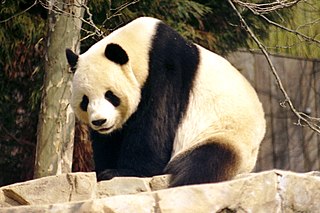
Animals are multicellular eukaryotic organisms in the biological kingdom Animalia. With few exceptions, animals consume organic material, breathe oxygen, are able to move, reproduce sexually, and grow from a hollow sphere of cells, the blastula, during embryonic development. Over 1.5 million living animal species have been described—of which around 1 million are insects—but it has been estimated there are over 7 million in total. Animals range in size from 8.5 millionths of a metre to 33.6 metres (110 ft) long and have complex interactions with each other and their environments, forming intricate food webs. The study of animals is called zoology.
Biodiversity in Israel and Palestine is about the fauna and flora in the geographical region of Israel and of the Palestinian National Authority. This geographical area within the historical region of Palestine extends from the Jordan River and Wadi Araba in the east, to the Mediterranean Sea and the Sinai desert in the west, to Lebanon in the north, and to the gulf of Aqaba, or Eilat in the south.

Monadofilosa is a grouping of Cercozoa. These organisms are single-celled amoeboid protists.
The following outline is provided as an overview of and topical guide to zoology:

Taxonomy of commonly fossilized invertebrates combines both traditional and modern paleozoological terminology. This article provides an overview of various invertebrate taxa found in the fossil record, ranging from protists to arthropods. The taxonomy discussed emphasizes invertebrates that are either frequently collected as fossils or are extinct. This includes groups that are significant in paleontological contexts, abundant in the fossil record, or have a high proportion of extinct species. Special notations are explained below:

In biology, taxonomic rank is the relative level of a group of organisms in an ancestral or hereditary hierarchy. A common system of biological classification (taxonomy) consists of species, genus, family, order, class, phylum, kingdom, and domain. While older approaches to taxonomic classification were phenomenological, forming groups on the basis of similarities in appearance, organic structure and behaviour, methods based on genetic analysis have opened the road to cladistics.
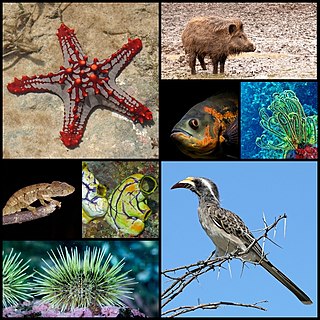
Deuterostomes are bilaterian animals of the superphylum Deuterostomia, typically characterized by their anus forming before the mouth during embryonic development. Deuterostomia is further divided into 4 phyla: Chordata, Echinodermata, Hemichordata, and the extinct Vetulicolia known from Cambrian fossils. The extinct clade Cambroernida is also thought to be a member of Deuterostomia.

Opalozoa is a subphylum of heterotrophic protists of the phylum Bigyra, and is the sister group to Sagenista. Opalozoans are non-photosynthetic heterokonts that are ancestrally phagotrophic but many times have evolved to be osmotrophic saprotrophs in the gut of vertebrate animals.

The sarcomonads or class Sarcomonadea are a group of amoeboid biciliate protists in the phylum Cercozoa. They are characterized by a propensity to move through gliding on their posterior cilium or through filopodia, a lack of scales or external theca, a soft cell surface without obvious cortical filamentous or membranous skeleton, two cilia without scales or hairs, tubular mitochondrial cristae, near-spherical extrusomes, and a microbody attached to the nucleus.

The Echinacea are a superorder of sea urchins. They are distinguished by the presence of a rigid test, with ten buccal plates around the mouth, and solid spines. Unlike some other sea urchins, they also possess gills. The group is a large one, with species found worldwide.
The following outline is provided as an overview of and topical guide to life forms:
The taxonomy of the animals presented by Hutchins et al. in 2003 in Grzimek's Animal Life Encyclopedia is a system of classification which covers all the metazoans, from phyla to orders.
The taxonomy of the vertebrates presented by John Zachary Young in The Life of Vertebrates (1962) is a system of classification with emphasis on this group of animals.
The initial version of a classification system of life by British zoologist Thomas Cavalier-Smith appeared in 1978. This initial system continued to be modified in subsequent versions that were published until he died in 2021. As with classifications of others, such as Carl Linnaeus, Ernst Haeckel, Robert Whittaker, and Carl Woese, Cavalier-Smith's classification attempts to incorporate the latest developments in taxonomy., Cavalier-Smith used his classifications to convey his opinions about the evolutionary relationships among various organisms, principally microbial. His classifications complemented his ideas communicated in scientific publications, talks, and diagrams. Different iterations might have a wider or narrow scope, include different groupings, provide greater or lesser detail, and place groups in different arrangements as his thinking changed. His classifications has been a major influence in the modern taxonomy, particularly of protists.











